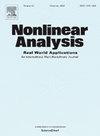Stability of the Prandtl boundary layer equation under various boundary conditions
IF 1.8
3区 数学
Q1 MATHEMATICS, APPLIED
引用次数: 0
Abstract
By the Crocco transformation, the boundary layer system of the viscous incompressible flow is transferred to a strong degenerate parabolic equation with a nonlinear boundary value condition, referred as the Prandtl boundary layer equation. The key technique in this paper involves applying the reciprocal transformation to convert the Prandtl boundary layer equation into a degenerate parabolic equation in divergent form. The main challenge arises on account of that the reciprocal transformation renders the initial value condition unbounded. To address this, a new unknown function is introduced, and the partial differential equation for is derived. For this new equation, the existence of these BV entropy solutions are proved by the parabolically regularized method, the maximal value principle is used to obtain the -estimate. Under certain restrictions on the data of the Prandtl system, the stability of entropy solutions is demonstrated using different boundary value conditions. Consequently, under the Oleǐnik assumption and the monotonicity condition, the two-dimensional Prandtl boundary layer system is shown to be well-posed through the inverse Crocco transformation.
不同边界条件下普朗特边界层方程的稳定性
通过Crocco变换,将粘性不可压缩流动的边界层系统转化为具有非线性边值条件的强退化抛物型方程,称为Prandtl边界层方程。本文的关键技术是利用倒数变换将普朗特边界层方程转化为发散形式的退化抛物方程。主要的挑战是由于逆变换使得初值条件无界。为了解决这个问题,引入了一个新的未知函数u1,并推导了u1的偏微分方程。对于新方程,利用抛物正则化方法证明了这些BV熵解的存在性,并利用极大值原理得到了其L∞估计。在一定的普朗特系统数据限制下,用不同的边值条件证明了熵解的稳定性。因此,在Oleǐnik假设和单调性条件下,通过逆Crocco变换证明二维Prandtl边界层系统是适定的。
本文章由计算机程序翻译,如有差异,请以英文原文为准。
求助全文
约1分钟内获得全文
求助全文
来源期刊
CiteScore
3.80
自引率
5.00%
发文量
176
审稿时长
59 days
期刊介绍:
Nonlinear Analysis: Real World Applications welcomes all research articles of the highest quality with special emphasis on applying techniques of nonlinear analysis to model and to treat nonlinear phenomena with which nature confronts us. Coverage of applications includes any branch of science and technology such as solid and fluid mechanics, material science, mathematical biology and chemistry, control theory, and inverse problems.
The aim of Nonlinear Analysis: Real World Applications is to publish articles which are predominantly devoted to employing methods and techniques from analysis, including partial differential equations, functional analysis, dynamical systems and evolution equations, calculus of variations, and bifurcations theory.

 求助内容:
求助内容: 应助结果提醒方式:
应助结果提醒方式:


